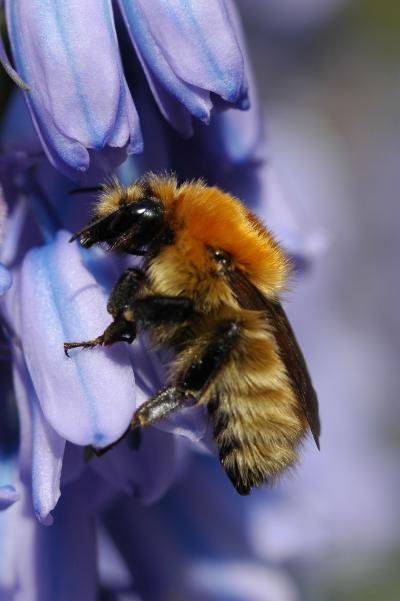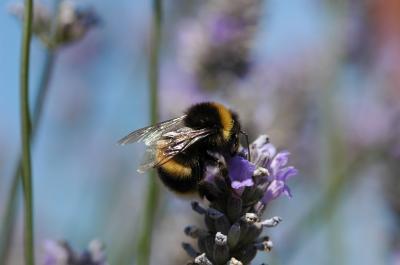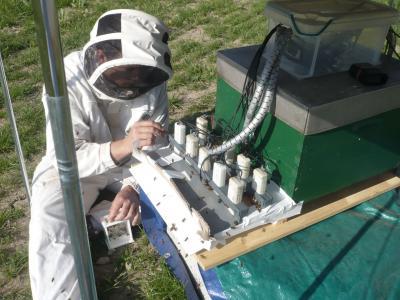A pair of new studies reveals the multiple ways that a widely used insecticide harms bumblebeesand honeybees.
The reports, one by a U.K. team and one by a French team, appear online at the Science ExpressWeb site of the journal Science, on 29 March, 2012. Science is published by AAAS, the nonprofit,international science society.
Bumblebees and honeybees are important pollinators of flowering plants, including many majorfruit and vegetable crops. Each year, for example, honeybee hives are trucked in to help pollinatealmond, apple and blueberry crops, among others.
In recent years, honeybee populations have rapidly declined, in part due to a phenomenon known asColony Collapse Disorder. Bumble bee populations have been suffering as well, according to DaveGoulson of the University of Stirling in Stirling, U.K., who is a co-author of one of the studies.
“Some bumblebee species have declined hugely. For example in North America, several bumblebeespecies which used to be common have more or less disappeared from the entire continent. In theU.K., three species have gone extinct,” Goulson said.
Researchers have proposed multiple causes for these declines, including pesticides, but it’s beenunclear exactly how pesticides are inflicting their damage.
Both of the Science studies looked at the effects of neonicotinoid insecticides, which wereintroduced in the early 1990s and have now become one of the most widely used crop pesticides inthe world. These compounds act on the insect’s central nervous system, and they spread to thenectar and pollen of flowering crops.
In one study, Penelope Whitehorn of the University of Stirling in Stirling, U.K. and colleagues

This is a moss carder bumblebee, Bombus muscorum. This image relates to a paper that appeared in the March 29, 2012, issue of Science Express, published by AAAS. The paper, by Dr. P.R. Whitehorn at the University of Stirling in Stirling, UK, and colleagues was titled, "Neonicotinoid Pesticide Reduces Bumble Bee Colony Growth and Queen Production."
(Photo Credit: Photo taken by David Goulson)
exposed developing colonies of bumblebees, Bombus terrestris, to low levels of a neonicotinoidcalled imidacloprid. The doses were comparable to what the bees are often exposed to in the wild.
The researchers then placed the colonies in an enclosed field site where the bees could forage undernatural conditions for six weeks. At the beginning and end of the experiment, the researchersweighed each of the bumblebee nests – which included the bees, wax, honey, bee grubs and pollen– to determine how much the colony had grown.
Compared to control colonies that had not been exposed to imidacloprid, the treated colonies gainedless weight, suggesting less food was coming in. The treated colonies were on average eight to 12percent smaller than the control colonies at the end of the experiment. The treated colonies alsoproduced about 85 percent fewer queens. This last finding is particularly important because queenproduction translates directly to the establishment of new nests following the winter die-off. Thus,85 percent fewer queens could mean 85 percent fewer nests in the coming year.
“Bumblebees pollinate many of our crops and wild flowers. The use of neonicotinoid pesticides onflowering crops clearly poses a threat to their health, and urgently needs to be re-evaluated,” saidGoulson.
In the other Science report, a French team found that exposure to another neonicotinoid pesticideimpairs honey bees’ homing abilities, causing many of the bees to die.
Mickaël Henry of the French National Institute for Agricultural Research (INRA) in Avignon,France and colleagues tagged free-ranging honeybees with tiny radio-frequency identification, or

This is a buff-tailed bumblebee, Bombus terrestris. This image relates to a paper that appeared in the March 29, 2012, issue of Science Express, published by AAAS. The paper, by Dr. P.R. Whitehorn at the University of Stirling in Stirling, UK, and colleagues was titled, Neonicotinoid Pesticide Reduces Bumble Bee Colony Growth and Queen Production.
(Photo Credit: [Photo taken by David Goulson])
“RFID,” microchips that were glued to each bee’s thorax. These devices allowed the researchers totrack the bees as they came and went from their hives. The researchers then gave some of the bees asublethal dose of the pesticide thiamethoxam.
Compared to control bees that were not exposed to the pesticide, the treated bees were about two tothree times more likely to die while away from their nests. These deaths probably occurred becausethe pesticide interfered with the bees’ homing systems, the researchers propose.In the second part of their study, the researchers used data from the tracking experiment to developa mathematical model that simulated honeybee population dynamics. When the mortality caused bythe homing failure was incorporated into the simulations, the model predicted that honeybeepopulations exposed to this pesticide should drop to a point from which it would be difficult torecover.
The authors note that even though manufacturers are required to ensure their pesticide doses remainbelow lethal levels for honeybees, the studies used to determine this lethality level have probablyunderestimated the ways that pesticides can kill bees indirectly, for example by interfering withtheir homing systems.
"Our study raises important issues regarding pesticide authorization procedures. So far, they mostlyrequire manufacturers to ensure that doses encountered on the field do not kill bees, but theybasically ignore the consequences of doses that do not kill them but may cause behavioraldifficulties," said study author Mikaël Henry of INRA, in Avignon, France.

Collecting honeybees at the entrance of an RFID beehive. This image relates to a paper that appeared in the MarCH 29, 2012, issue of Science Express, published by AAAS. The paper, by Dr. M. Henry at INRA in Avignon, France, and colleagues was titled, "A Common Pesticide Decreases Foraging Success and Survival in Honey Bees."
(Photo Credit: [Image © Science/AAAS])